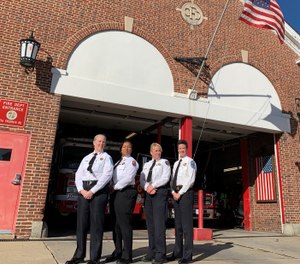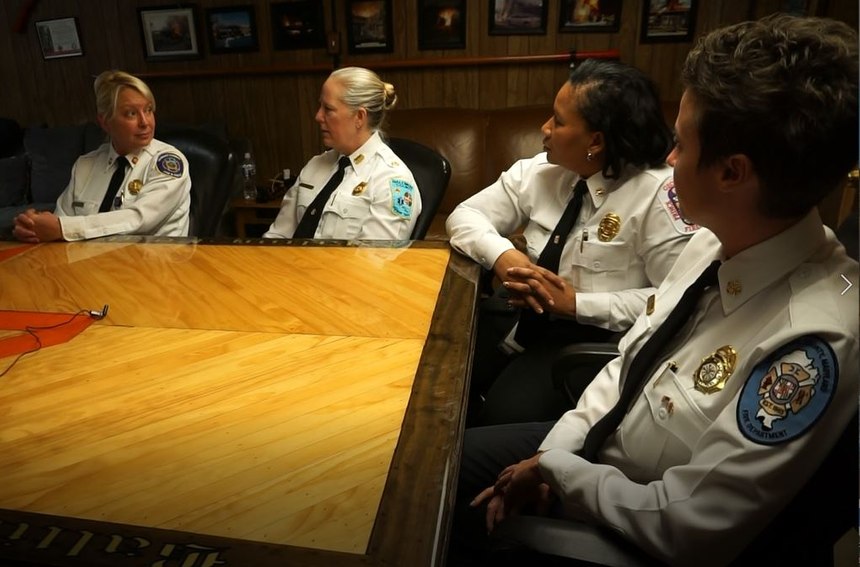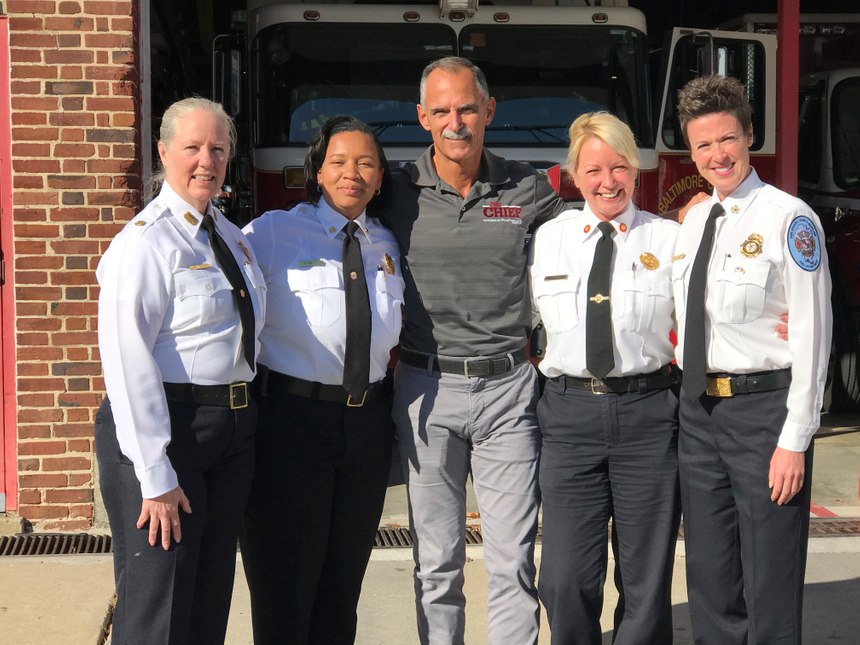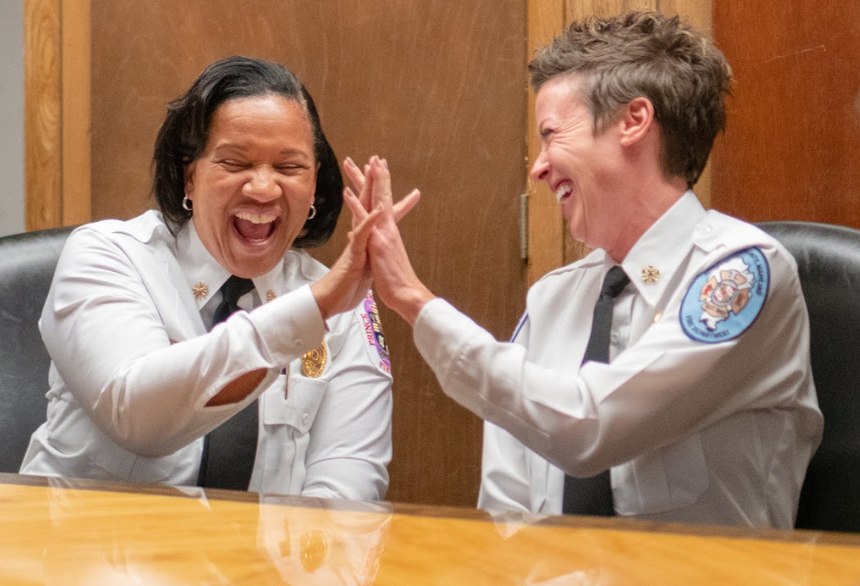Breaking barriers: The 4 female chiefs of the National Capital Region
The women offer insights for tackling challenges to inclusiveness in the fire service – and pushing back against the “haters”
Yesterday at 12:45 PM
It is no secret that from the earliest beginnings of the fire service, this has been a male-dominated vocation. But through the years, more and more women began joining the ranks, and now, the perception that this is a male-only job is as antiquated as horse-drawn steamers – but that doesn’t mean some people don’t still balk at the idea of women leading the charge and put up roadblocks to hamper progress.
History, struggles and progress
Molly Williams, a slave in New York City, is generally acknowledged as the first female firefighter – a volunteer with the Oceanus Fire Company #11 around 1815.

For the Boston Fire Department, it would be 1984 – 306 years after the department was formed in 1678 – before the first female firefighter would be hired.
Thirty-four years later, multiple media outlets covered the release of a December 2018 report issued by the city of Boston deriding the lack of female firefighters in the Boston Fire Department. At the time of the report, there were only 16 female firefighters, out of 1,500, working for the department.
The City of Boston has taken steps to improve female representation, including work toward implementing the 21 recommendations from the report. And there is progress. On Nov. 24, 2019, Deanna McDevitt, a fourth-generation Boston firefighter, became the first woman promoted to division chief for the department.
Other areas of the country – particularly the National Capital Region – paint a different picture of progress for women in the fire service.
I had the honor to sit down with four female fire chiefs at historic Catonsville, Maryland, Fire Station #4. The four chiefs all head large combination paid/volunteer department in the Baltimore and Washington region of Maryland:
- Anne Arundel County Fire Department Fire Chief Trisha Wolford
- Baltimore County Fire Department Fire Chief Joanne Rund
- Howard County Department of Fire and Rescue Services Fire Chief Christine Uhlhorn
- Prince George’s County Fire/EMS Department Acting Fire Chief Tiffany Green
The women were gracious to spend a day talking about their priorities, their passions and their struggles as the first female fire chiefs for each of these jurisdictions.

Getting to know the four chiefs
Having previously served in Prince George’s County, coupled with my involvement with the Metropolitan Fire Chiefs Association, I have had the pleasure to get to know each of these chiefs personall
Host Chief Baltimore County's Joanne Rund – also a member of the FireRescue1/Fire Chief Editorial Advisory Board – shared some history of Catonsville Fire Station #4, which was built in 1914, making it the longest continuously operated station in the area – quite a symbol of the past meeting the future. As the five of us sat together at the kitchen table, it was hard to not imagine how the walls must have been talking about a female chief, let alone four, sitting together and talking about their struggles and opportunities in the fire service.
Chief Rund commented on the tremendous weight and accomplishment she feels, having been selected from outside of Baltimore County to head the department: “Five years ago, and at five years in, I would have never guessed I’d be sitting here today. [I worked to] climb through the ranks, have had a feeling of mission, which became a drive – and here we are 32 years in fire service later.”
Rund is Baltimore County’s 27th chief since 1881. Baltimore County boasts 1,069 paid firefighters and 800 volunteer firefighters, covering 610 square miles and answering approximately 150,000 calls annually.
My connection to Prince George’s County Acting Fire Chief Green extends back to my time as Prince George’s County’s 11th fire chief, when I had the honor of promoting Green three times to ascending roles within the organization. She now works toward becoming Prince George’s County’s 13th fire chief.
Green, with 21 years on the job, commented: “For me, [the challenge] is two-fold, not just a woman but an African-American female. So it’s kind of bittersweet to be the 13th chief and to be the first female, but it’s also sad that there’s only three other African-American female chiefs currently serving in the world.”
At a mere 25 days into her tenure at the time of our interview, Green also acknowledged the weight and opportunities for success. Prince George’s County Fire/EMS has 968 paid firefighters and 1,500 volunteer firefighters, covering 480 square miles of land and an additional 20 square miles of water, including the Potomac River. The Department answers over 151,000 calls for service annually.
Chief Wolford, with 14 years of fire service experience, “took the long road around,” she said, having previously worked in Anne Arundel County as a firefighter before accepting a position in the Bozeman (Montana) Fire Department, then an assistant chief’s position in the Spokane (Washington) Fire Department.
Wolford is Anne Arundel County’s 12th fire chief since 1965 (the first three were called administrators). Anne Arundel County has 1,000 paid firefighters and between 300 and 600 volunteers, covering approximately 414 square miles of land and an additional 170 square miles of water, including the Chesapeake Bay and its tributaries. The Department answers over 85,000 calls for service annually.
With almost 31 years of service, at the time of the interview, Howard County Chief Uhlhorn declared that she was “16 days from retirement.” The statement came as somewhat of a shock to the group; however, the story is that she was supposed to retire due to the “drop” in 16 days – a decision, of course, made before her 2018 selection as chief. Serving as Howard County’s 11th fire chief, Uhlhorn commands a force of 453 paid firefighters and approximately 500 volunteer firefighters.
Attitudes of unwelcomeness drive motivation
As I started to address “a time when women were not welcomed in the fire service,” my comment was quickly cut off. Chief Uhlhorn commented, “A woman, OMG, and CHIEF? Oh no!” Collectively, the women made sure that I would know they believe the unwelcomeness still exists today.
Chief Rund asked, “You think we don’t hear that today? It is still very real!”
As they talked about other female chiefs around the country, Chief Wolford echoed Rund, “It’s still very real … I’m sure the walls are talking right now.”
Speaking to how these challenges impact their work running a department, Chief Uhlhorn explained, “All of us have been in the system long enough; we’re used to it, accustomed to it, it hasn’t deterred us, we believe in ourselves. They can talk all they want, I know that I’m qualified.”
Chief Green likened the “talk” to a challenge: “There is a motivational factor that comes with it – kind of a thank you for the haters.”
The “haters” comment drew collective laughter and agreement that, “Haters are always motivators.” That kind of reverse-motivation, as Chief Green explained, “propels you to be the best, and I think in this group, we are the best … we are the trailblazers, every decision, every mistake we make is broadcast on a different level, and we’re setting the path forward for the next group, and it’s a lot of responsibility there. I think it’s more for us than it is for men.”
Finding mentors – and family support
When it comes to mentorship for women in the fire service, we talked about other female chiefs over time, with names like Mary Beth Michos (Prince William County, Virginia; IAFC senior advisor), Rhoda Mae Kerr (Little Rock, Arkansas; Austin, Texas; Fort Lauderdale, Florida; former IAFC president) and Toni Washington (Decatur, Georgia) drawing praise from the group. There were plenty of internal and external role models and mentors as well who helped the chiefs excel.
Chief Wolford talked about “coming in, internalizing, watching social mechanics, and everything other female chiefs did.” She also shared an experience from attending Fire-Rescue International (FRI) conference and finding the female-fire chief mecca! “I opened the door, found the mecca of five-bugle women at FRI, went around and talked to each one. I had to tell them, you’re now my friend, you’re now my friend … there really aren’t that many of us, so finding that large group was good.”
Each of the chiefs acknowledged male and female counterpart mentors and icons of the fire service who impacted and helped propel them.
Chief Rund relayed an early-career story: “My officer was Mike Dorsey, on an all-male shift. I was easily intimidated. I mean, these were great guys, but I was a perfectionist and felt the intimidation I brought on myself. Mike knew that I was always hard on myself, so he would always take that extra step to show me. He could tell when I wasn’t happy with my performance, and he would take me aside afterwards and we would talk about it, always had that voice of reason.”
Chief Uhlhorn’s spoke to her family’s support, as it evolved over the years: “My dad was a firefighter in Baltimore City for 36 years, my grandad also. We have over 250 fire service years in the family, so I’ve done my share at 31 years. Early in kindergarten, my mom still has this picture, we had to draw this picture of what we wanted to do when we grew up. I came home with a fire truck. I drew a fire truck. I drew me with my blonde hair and fire helmet and gave it to my dad. No one ever said, ‘You can’t do that, you can’t be a fireman.’”
She continued: “When I told my dad I was joining as a volunteer, and I told him I wanted to go career, my dad was old school, I’m not going to lie. He told me he didn’t know if women belonged in the department. I said OK – and here we are!”
Chief Uhlhorn spoke about this period of pain in her life with some laughter, continuing: “When I went in the Academy, dad told me he wanted me to come to his station, Truck 8 Baltimore City, when I got out of class, while he was working. I remember his shift members would say, ‘Frank, you’re killing her.’ He had me throwing ladders myself, he’d block Frederick Road and had me climbing the aerial at 90 degrees, using axes, everything – this was after all day in the Academy. So I’d leave the Academy crying and go down Frederick Road to my dad to be tested. And when I graduated, he pinned me, and he told me, ‘I don’t know if women belong in the fire service, but I know you do.’”
Much like my own story, Chief Green said no one else in her family has a fire service background: “My story is purely about public service, as I joined as a volunteer after fulfilling a ride-along requirement for a George Washington University EMT program I was in. My mentors in the fire service were actually males – I was happy as a firefighter, loved what I was doing, but they pushed me to promote. They saw something better, something that I didn’t see. I was happy, fine being a firefighter in my mind forever. Once I took the first promotional exam, it was a bug or that desire, something that propelled me.”
It is somewhat surprising to me that the only department at the table with a formal mentoring program is Howard County.
Chief Uhlhorn shared information about a new officers mentor program, but also St. Florian’s Brigade, a program that has been mentoring women in the fire service for 5 or 6 years. “We assign a female mentor to women in the Academy, so they can call them, ask them any questions, prepare them for their time in the fire service, like a ‘big sister’ program,” Uhlhorn explained.

Tackling remaining challenges for inclusion
The chiefs shared advice for how to tackle the remaining barriers to better inclusion in the fire service.
Chief Green said a lot of the challenges that remain stem from the history of the individual departments – and the fire service as a whole – coupled with the perception that women can physically do the job: “Advice I’ve given other women on the physicality is to understand there’s always more than one way to do things. Realize your body makeup is never going to be the same as the man, but there are techniques in training that come from training and dedication – focus on mastering physical fitness, make sure you’re comfortable and competent, and don’t let THEIR perception become your reality.”
Chief Wolford stressed the importance of self-awareness and self-confidence: “Don’t get pushed one way or the other, don’t worry (so much). Like most of us, we worked in all-male crews at some point, but it’s the ones who don’t have that self-confidence that need the help. I know several strong women in the department, they don’t have 20 years in, but they don’t have two years in … they’re in that sweet spot where they realize, this is who I am, and I’m really good at who I am. We’ve all been there.”
Chief Uhlhorn advised to not be afraid to fail and to admit your mistakes: “I own my failures, and I learn from them and I publicize them so hopefully somebody else can learn from them.”
She added that it’s vital to be yourself as well: “I think a problem a lot of women struggle with is they want to be one of the guys. My advice is you don’t need to be one of the guys to be competent. Be yourself, embrace the way you do things and push it out to other women – you can be a women and be successful in the fire service you can be a heck of a firefighter. Your gender does not drive what you can be, and it shouldn’t.”
Chief Rund echoed this sentiment: “Be comfortable in their own skin. Took me a long time to get there, just my personality. Set goals. It is important to set goals for yourself and don’t be afraid to ask questions and seek advice.”

Single piece of advice for fellow firefighters
Dovetailing on how to best tackle the remaining fire service challenges, I asked each chief to offer one piece of advice, for female firefighters in particular, but really everyone in the fire service.
Chief Wolford: “This position is about grit and hustle. Keep your butt in the chair and your face in the community.”
Chief Green: “Work-life balance. You gotta figure out that gym time. Generally, women are used to being the nurturer in the family, so you have both [a family and department] you’re nurturing.
Chief Rund: “Invest in people.”
Chief Uhlhorn: “I agree with everything. My advice is work/life balance. I’m a single mom, and this is non-stop, and you really have to take time, which I’m not, but I hear their advice and I hear me giving it, but you really do need to take time for yourself.”
Looking ahead and prioritizing projects
When all is said and done, the chiefs aren’t focused on the haters or the hurdles. They are dedicated to their departments – their members and their communities.
Chief Uhlhorn is focused on carcinogen reduction – purchasing second sets of gear and clean cabs: “We’re a small department, but we have a large percentage of people with cancer.” Chief Rund is similarly focused on health and safety in general as well as infrastructure and apparatus. Chief Green is tackling mental and physical wellness, risk reduction and community engagement. Chief Wolford is eyeing infrastructure.
Man or woman, all chiefs will be measured by their abilities to lead their people and their departments through thick and thin. These chiefs have the energy and drive to succeed, which will continue propelling their departments’ successes.
Comments
Post a Comment